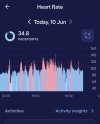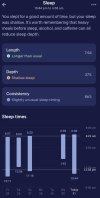MrMagoo
Senior Member (Voting Rights)
Well, yes as you’ve discovered, once you’re in the red it takes time to get back out of it, stopping what you’re doing isn’t enough as the heart rate needs to drop.Thanks MrMagoo. I think I did in fact properly understand that, but thank you for clarifying. My confusion is that the daily score seems rather random, and though I guide myself using it, and pace correctly, the outcome for the next day seems just as likely to be worse, equal or the same, when I would hope for equal or the same. It's still confusing. Perhaps it will stabilise a bit.
Yes, that's what was explained to me. You simply consume pace points four times faster when in "over exertion" compared to "activity" and that's what I find counterintuitive. So when I was walking with my son yesterday and I was unable to get out of "over exertion" however slow I walked (as we were on a slight incline), the best thing to do would have been to have speed walked for 5 minutes (or best I could do) rather than walked slowly for 10 minutes which would have used twice as many points. That way, though I would be more exhausted, I would have used half as many Pace Points reaching our destination. Walking slowly by still over the limit is implied to be tougher on me for banked PEM, than hurrying up.
But there is a real flip side which I've noticed which probably compensates for this. When over exerting significantly, I've noticed that it can take an hour or more for me to return to anywhere near the same heart rate I was before pushing myself, and if it really is extreme, I may never enter rest again on that day, so perhaps that's how you do end up consuming the "saved" points (by speeding up) and the argument is academic.
That's brilliant thanks, apart from the enormous guilt and embarrassment I'm now feeling over the 25 Pace point budget I've set for myself (I felt the 20 recommended was unworkable for me to start with), compared to the 3.7 that the person writing that article was constrained to use. I guess that's the difference between mild to moderate ME/CFS and somewhat more severe, which makes me feel very humble.
I personally took the view that in general with any objective feedback, it is better to feel that you are succeeding when you are trying to rather than failing all of the time. I can see many on this chat who just report that they are constantly over budget, and once you accept that being over budget is inevitable, there's probably less motivational incentive to keep within your goal, analogous to sticking with any kind of diet!
Comparing points is a zero-sum game, I’m on 90 per day and I’m moderate, I am working on ways to stay closer to my budget but it isn’t easy. I’m also going to ask to be investigated for POTS.



